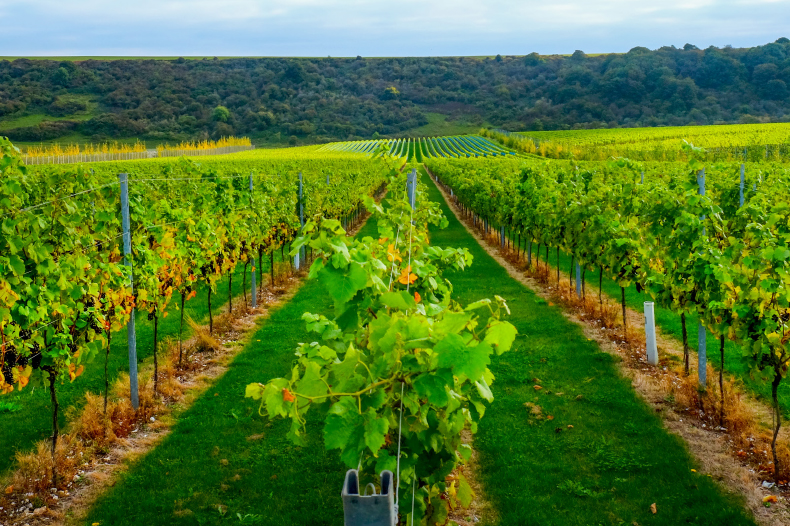Say hello to SUSSEX
Dominic Farnsworth raises a glass to the success of a new PDO.

English wines have historically been met with derision on the international stage.
Our wine producers have been seen by many as eccentric hobbyists struggling to grow grapes in a climate that is just too cold to ripen grapes sufficiently. How things change.
The chalk beds that are a major contributor to the quality of French Champagne stretch under the Channel before surfacing in England and this, combined with global warming, means that England is now producing award‑winning fizz that more than holds its own against premium sparkling wine from around the world.
Bottles of Nyetimber, Gusbourne, Rathfinny, Chapel Down and Ridgeview are a common sight on both supermarket shelves and restaurant wine lists in the UK and, increasingly, abroad.
It is somewhat telling that the Champagne houses, recognising this quality and mindful of the risks posed by climate change to their vineyards, are snapping up English vineyards.
The market is in a period of high growth, with industry body WineGB reporting a 69% increase of sales of English and Welsh wines in the period from 2019 to 2021. Last year alone, 1.7 million new vines were planted.
Against this backdrop, we are beginning to see the expansion of Geographical Indications (GIs) into the UK wine market.
GIs protect product names that originate from a specific place and possess qualities or a reputation based on that origin, thus guaranteeing authenticity.
There are two classes of GI: Protected Designation of Origin (PDO) and Protected Geographical Indication (PGI).
For fine wines, where origin is so tightly connected to quality, PDO is the desired certification, requiring that grapes come from the same area and all stages of the production process are undertaken there.
In June 2022 the Sussex Wineries group announced that the Department for Environment, Food & Rural Affairs (Defra) had granted “SUSSEX” PDO status for still and sparkling wines produced in Sussex (the geographical area covering the combined counties of East Sussex and West Sussex), which produces approximately 25% of all UK wine.
In this respect, Sussex has now joined the list of well‑known and similarly protected UK PDOs including Stilton Cheese and Cornish Clotted Cream.

To qualify for this status wines will be subject to strict requirements, which for sparkling wines include: a limited geographical area in which the grapes can be grown and the wine produced; permitted varietals of grape to be used; hand harvesting; maximum yields; minimum alcohol by volume of 11%; the production method used (this must be the “traditional method”, the same as used in Champagne and Cava); and bottle‑aging requirements pre‑release to market.
Finally, the wine needs to be tested, tasted and approved by an independent review body before it can claim PDO status.
Not all of the UK wine industry has welcomed this news. Some wineries within Sussex buy in grapes from outside the county.
If they blend these into their Sussex‑originated wine the blend can no longer be designated as Sussex.
Meanwhile, if they bottle their Sussex‑grape wine separately and use the PDO then there is a risk of a large tranche of their non‑Sussex production run being regarded as somehow lesser in quality.
Reservations are not solely commercial – some go to the heart of the fundamental purpose of a GI.
It is supposed to acknowledge the quality specific to the origin of a particular product, which, for wines, is linked to geographical issues of soils, altitude, aspect and drainage.
Why then have the boundaries of the PDO been defined by the arbitrary administrative borders of counties that are clearly not determined by such factors?
Sussex Wineries, with much support, claims the PDO is to the consumer’s benefit as the public will have confidence, relying on the PDO, that the wines can be guaranteed to come from one of England’s premium‑quality production areas and to have satisfied the stringent quality control criteria that such wines must meet.
New World wisdom
So what does the future hold for UK wine post‑Sussex PDO? For clues, we can look to New World wine‑producing areas such as the US and Australia.
In the US, viticulture areas are protected as American Viticultural Areas (AVAs). Napa Valley in California is the most famous of these.
Originally, the Valley as a whole was granted AVA status. Over time, as different factors have been established that differentiate one zone of the Valley from others, 16 different sub‑regions within the Valley have now been granted their own AVA status.
In Australia, nine viticultural sub‑regions have been identified within the Margaret River region. They have not yet been formally recognised, but pressure is building.
Both of those examples pale by comparison to Burgundy in France, where centuries of monitoring the variations between different vineyards has led to 84 zones having Appellation d’Origine Contrôlée status (and within those 562 Premier Cru and 33 Grand Cru individually defined vineyards).

One can therefore expect to see other UK areas, perhaps counties such as Kent and Hampshire, also applying for PDO status since they are producing high‑quality wines from those same chalk beds, but are now missing out on the PR spin that Sussex can give to its wines.
Beyond that, over the coming decades we can reasonably anticipate that, in common with the more developed wine regions we’ve mentioned, more tightly defined sub‑zones within existing PDOs will start to emerge.
Interestingly, the smallest PDO in respect of wine is one that is limited to one vineyard. Here, England has a surprise up its sleeve. Sussex is not the first UK wine PDO.
That honour falls to Camel Valley Vineyards in Cornwall, which in 2017 was awarded a PDO for DARNIBOLE for its wine produced using the Bacchus grape.
Cross‑border complexity
It must be noted, in relation to new PDOs, that the protection of GIs has become significantly more complex following Brexit.
First, there is the issue of mutual recognition between the UK and EU of each other’s GIs. This at least is now clear, since from 1st January 2021 any GI having UK origin and EU protection is able to maintain this in the EU, under the EU‑UK Trade and Cooperation Agreement.
At the same time, those GIs having an EU origin continue to be recognised in the UK.
However, any pending or new applications for GI status for UK products need to be submitted first through the UK process and then if successful through the EU process, should EU protection be required.
Second, there is the position as regards Northern Ireland (NI).
There is a strong political and economic desire to avoid a “hard border” between NI and the Republic of Ireland and also GI‑specific complications, since certain products, such as Irish Whisky, fall under a GI that encompasses both NI and the Republic of Ireland.
This has resulted in NI remaining under the EU scheme, whereas England, Wales and Scotland will use the new UK process.
The PDO application for SUSSEX was made back in 2015, with Defra granting temporary approval before submitting to the EU authorities in 2016 for approval under the EU GI scheme.
The application was pending as at 1st January 2021 and so reverted to Defra for consideration under the new UK GI scheme, receiving GI status some 18 months later.
If Sussex Wineries wishes to extend protection of its PDO throughout the EU, then a further application will need to be made.
SUSSEX was the second UK PDO to be granted, the first being Gower Salt Marsh Lamb.
Wider trends
The UK is the second largest wine importer in the world, one of the hubs of the international wine market and a major force in product and packaging innovation and related advertising in the beer, wine and spirits (BWS) sector.
Many readers will have noticed the uptick in drink‑related work over the last decade, especially as the alcohol‑free product category is also in growth.
The explosion in craft beer brewing (in the UK an increase from 1,489 to 2,426 breweries since 2018), with each brewer offering a range of different brands, has spawned plenty of need for IP advice in respect of searches, registration programmes and sponsorship, advertising and brand partnerships.
The spirits market has been particularly dynamic. Gin distilleries in the UK grew from 710 to 820 in 2021 alone and industry intelligence is that other sectors such as rum and tequila have not yet hit their stride in terms of new product innovation.
Old, established brands are not standing still either, bringing many different flavours of gins and vodkas to retailers’ shelves. Scotch Whisky is now using different “finishes” (maturing Whisky in old Sherry, Port, Bourbon and Cognac barrels to help sculpt flavour) to expand its premium ranges.
Less fettered by tradition, spirits have also been the focus for radical development in bottle shape and packaging, which has led to some interesting product get‑up disputes.
The BWS sector will continue to provide a rich seam of interesting work to IP lawyers over the coming years, but beyond the usual cut and thrust of brand protection work, the opportunity to have a hand in the creation of future PDOs for England’s accelerating wine industry should be an intriguing and professionally rewarding challenge.





